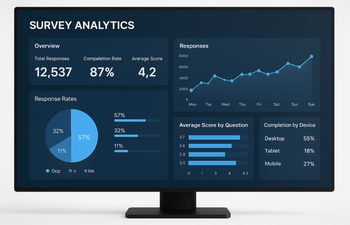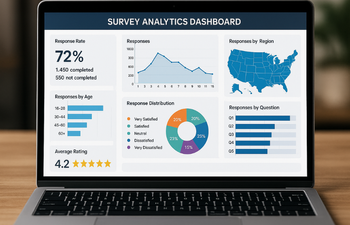Survey Fatigue Is Real: How to Spot It and What You Can Do About It
Learn to identify and combat survey fatigue. Discover actionable tips to reduce respondent burnout, improve data quality, and boost survey engagement today!

Introduction
In today's data-driven world, surveys are everywhere. From pop-up customer satisfaction forms to post-purchase feedback requests, businesses are constantly gathering insights. But there's a hidden cost: survey fatigue. This subtle but pervasive problem can compromise the quality of data and damage the relationship between organizations and their audience. Recognizing survey fatigue is essential to ensure your data remains meaningful and your audience stays engaged.
What is Survey Fatigue?
Survey fatigue refers to the decline in the quality and quantity of survey responses due to excessive or poorly designed survey requests. It manifests in two forms: pre-survey fatigue, when respondents avoid the survey altogether, and mid-survey fatigue, when participants begin the survey but drop off or rush through answers without thought.
Why Survey Fatigue is a Growing Concern
As digital communication becomes more accessible, businesses have leaned heavily on surveys. But this ease of use has created a saturation point. Customers feel overwhelmed, which leads to disengagement. Companies need to take a more strategic and empathetic approach to survey distribution.
Spotting the Symptoms of Survey Fatigue
The early signs are often subtle but measurable. Here’s how it typically appears:
- Decreased response rates
- Increased drop-offs before survey completion
- Straight-lining answers (selecting the same option repeatedly)
- Nonsensical or rushed responses
- Feedback expressing frustration with surveys
Why Respondents Drop Off
Understanding the psychology behind disengagement helps to prevent it. People are time-sensitive. If your survey feels too long or irrelevant, they’ll bail. Others feel their opinions won’t matter or assume their answers won't result in change, so why bother?
The Psychology Behind Survey Burnout
Respondents want to feel valued. When a survey is too generic, too frequent, or lacks a clear purpose, it sends the message that their time is expendable. That leads to apathy, which spirals into disengagement.
Types of Survey Fatigue
Real-World Examples of Survey Fatigue
A retail chain noticed a dramatic dip in survey participation after they started sending weekly post-purchase surveys. Customers felt bombarded. In contrast, a competitor who spaced their surveys quarterly saw higher engagement and more thoughtful feedback.
Impact on Data Quality
Survey fatigue skews your results. Fatigued respondents may answer randomly or not at all. This reduces the reliability of your data and can lead to poor decision-making.
Measuring Survey Engagement Metrics
To combat fatigue, track the following:
- Open and click-through rates on survey invitations
- Drop-off points within the survey
- Time spent per question
- Survey completion rates
How Survey Length Affects Fatigue
Lengthy surveys are a major turnoff. A 10-minute survey may see 80% completion. Stretch that to 20 minutes, and you may lose more than half of your audience.
Frequency: How Often is Too Often?
Even short surveys can cause fatigue if sent too frequently. Respect your audience’s time. Limit outreach to meaningful moments.
Personalization Matters
Generic surveys signal a lack of care. Personalize your surveys based on customer behavior or experience. Tailored questions increase relevance and response rates.
Design and UX Considerations
Clunky interfaces lead to frustration. Mobile-optimized, user-friendly design improves engagement. Keep your questions clear and your layout intuitive.
How to Reduce Survey Fatigue
- Keep surveys short and focused
- Use skip logic to avoid irrelevant questions
- Space surveys out appropriately
- Personalize the content
- Offer tangible incentives
For more tips on improving survey response rates, see our post on How to Boost Your Survey Response Rate: 7 Proven Tips.
Implementing Survey Logic
Smart surveys that adapt to responses, using branching or skip logic, feel more conversational. They reduce the number of unnecessary questions, improving the experience.
If you're interested in crafting better survey questions, check out our article on How to Write Survey Questions People Actually Want to Answer.
The Role of Incentives
Incentives can combat fatigue by adding value to participation. Even small rewards like discount codes or entries into a giveaway can significantly boost response rates.
Communicating the Purpose of the Survey
People are more likely to engage when they understand why you’re collecting feedback and how it will be used. Transparency builds trust.
Sharing Survey Results
Close the loop. Let respondents know their input made an impact. Sharing results or updates from the feedback increases future participation and reduces skepticism.
Timing Your Survey Delivery
Timing matters. Avoid sending surveys during busy seasons or late at night. Weekday afternoons typically yield higher response rates.
Segmenting Your Audience
Avoid over-surveying your entire customer base. Segment your audience and alternate feedback campaigns to avoid burnout.
Tools to Monitor Survey Health
Use analytics platforms that track engagement metrics. Many modern survey tools offer real-time dashboards to flag fatigue indicators.
Leveraging AI to Improve Surveys
AI can analyze past responses and engagement to optimize future surveys. Predictive models can recommend the ideal time, length, and content for each audience segment.
Survey Fatigue Is Real
Acknowledging that survey fatigue is real is the first step toward combatting it. It’s not just a buzzword, it’s a barrier to better data. By understanding the causes and taking strategic steps to minimize friction, you can preserve respondent goodwill and gather more accurate, actionable insights.
Conclusion
Survey fatigue is more than an annoyance, it’s a silent saboteur of meaningful feedback. If you're not actively addressing it, you’re risking skewed data, poor decision-making, and lost trust. Fortunately, the solution isn’t complicated. Respect your audience’s time, make participation easy and rewarding, and most importantly, act on the feedback you receive. When done right, surveys remain a powerful tool, not a burden.
Frequently Asked Questions
Find answers to the most common questions about this topic
Survey fatigue is often caused by long, repetitive surveys, over-surveying the same audience, or poorly designed questionnaires that lack relevance.
Common signs include low response rates, incomplete answers, rapid or random clicks, and drop-offs midway through the survey.
Survey fatigue can lead to skewed data, low-quality feedback, decreased participation in future surveys, and respondent disengagement.
By sending shorter, targeted surveys, spacing them out appropriately, personalizing content, and offering incentives, businesses can reduce fatigue.
Yes, fatigued respondents are more likely to provide careless or dishonest answers, which compromises the integrity of your data.
Yes, using smart survey platforms that adapt to user input and track response behavior can help minimize fatigue and improve engagement.









